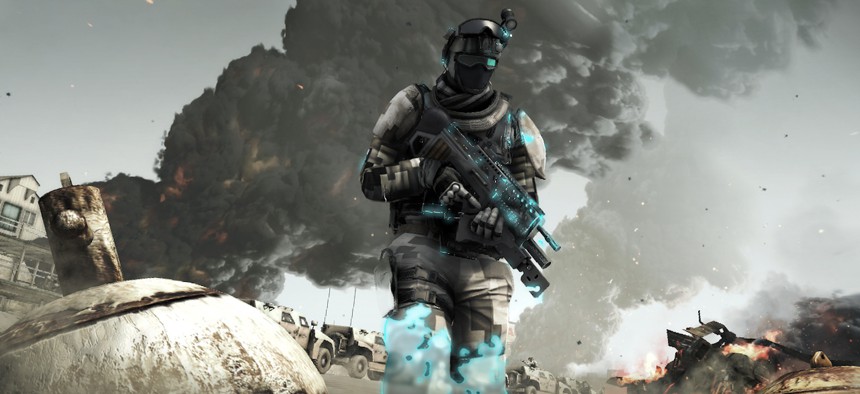
An illustration from Ubisoft's Ghost Recon Future Soldier. UBISOFT
The Army Team That Is Trying to See, and Shape, the Future
The team’s scientists are charting how advances in various fields will unlock more advances, out to 2050.
An eight-month-old team at U.S. Army Futures Command is putting a 21st-century spin on a Cold War idea: employing technology scientists and watchers to forecast trends and help prepare for war in coming decades.
Like Herman Kahn at RAND in the 1940s, Team Ignite scans the technological horizon for upcoming advances in electronics, artificial intelligence, space, biotech, and more. Its forecasts, informed by data and machine learning, are intended to help the Army arm, organize, and train itself for conflicts around 2040 to 2050.
“I don't think there's been a time when we have had scientists as well infused into concept development as we do now and that's all the Team Ignite effort,” Lt. Gen. Eric Wesley, deputy commander of Futures Command, said at the recent Defense One Tech Summit. “We're not just writing concepts that say, ‘Hey, we need to do this. Scientists, go build me this widget’.”
Rather, the role of the scientists is to survey the tech landscape, see how some breakthroughs will lead to others, and then create scenarios and concepts for how those technologies will shape not just what the Army does but what adversaries might do as well.
“There's a dialectic there, because now we have scientists, saying, “Hey… what if this was possible. Would you change the way you write your concept?” … That conversation was the purpose or intention of Team Ignite.”
The job of technology forecasting has changed dramatically over the past few decades, thanks largely to the exponential growth of computing power. For example, a recent paper from the Northwestern University Institute on Complex Systems describes how artificial intelligence can help predict which new scientific studies will be most reproducible. The research, which was funded by the U.S. Army Research Office, could provide a clue to the likely direction of future technological development and suggest the most profitable R&D investments.
The Ignite team takes a similar approach to understanding what breakthroughs are going to shift scientific investment, research, and development in the years ahead. But they also connect those insights to what the Army is actually doing, using what Ignite scientists call a discovery tree. They apply data and analytics to see how one breakthrough will set the field to allow another breakthrough to help the military determine both how to invest and how to train.
“The goal of the discovery tree is to provide a pathway from [science projects] to operational advantage,” said Ignite’s senior science lead, Jean Vettel, who is also chief scientist for Futures and Concepts Center and a neuroscientist at the Army’s Combat Capabilities Development Command. “Whenever we take a scientific idea, that idea is usually good in the laboratory, but then we have to figure out, how do we put that into a robust, less controlled environment? That’s a lot of what we do in tech development efforts.”
Then, she said, “we have to figure out how we integrate into an Army system that can actually be procured and bought and delivered and how to have an acquisition system to make that procurement...efficient.”
“Any particular scientific discovery has to be matured, moved, iterated on, in order to actually deliver something that the Army wants and it is that pathway out that the discovery trees are trying to build.”
Understanding those interconnections among advancing fields of science is creating new insights into future war, allowing the team to build out scenarios and ultimately recommendations for new concepts of operation.
One upcoming report will focus on moving forces around the battlefield. “Maneuver has probably changed,” said Col. Rory Crooks, a team member. “We’re drilling down into the character of maneuver. We’re considering things like cognitive maneuver that we really haven’t [considered] before… What happens in the information environment, for example, it can have measurable impacts in terms of your freedom of action. You can improve yours [and] limit your adversaries in terms of cognitive maneuver.”
Emerging technology, and the possibility of better integrating space, cyber, and information into attack plans, is also changing the Army’s thinking on standoff attacks — attacking a target from a safe distance. Traditionally, that has meant lobbing missiles into enemy territory. But the advent of cyber, information warfare, directed energy and autonomous armed drones is changing the fundamentals of overwhelming an adversary from a distance.
“In the past,” Crooks said, “massing meant getting all your guns pointed at the same target and you pound it with as much artillery as you can. You have enough in a small area eventually the probability of kill will allow you to achieve the effect you want to achieve. But because of the nature of either the non-kinetic effects you are trying to employ…and the ability to layer different types of intelligence” — signals intelligence, open-source intelligence, satellite photos, etc. — “if they’re all connected, they can give you a precision that we haven’t had before.”
The ability to much better collect intelligence from the battlefield and then deliver massive effects of various forms to any target is ultimately how the U.S. would prevail in a major conflict — or at least, that’s what the current thinking indicates.
“We have the ability to mass in multiple domains, not just the kinetic, physical surface to surface domains. And we have this ability to mass with precision. That’s kinda of new and different. That’s what makes up convergence, this idea that you can mass with precision, in depth [as in well into enemy territory] to achieve overwhelming cognitive effects. Your adversary is now limited in his field of action and you have increased your field of action to maneuver to an area of relative advantage,” he said.




